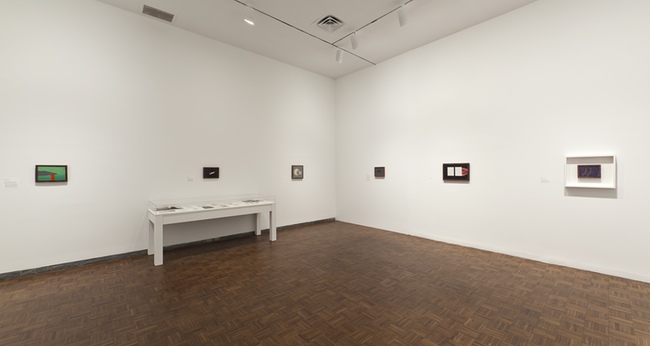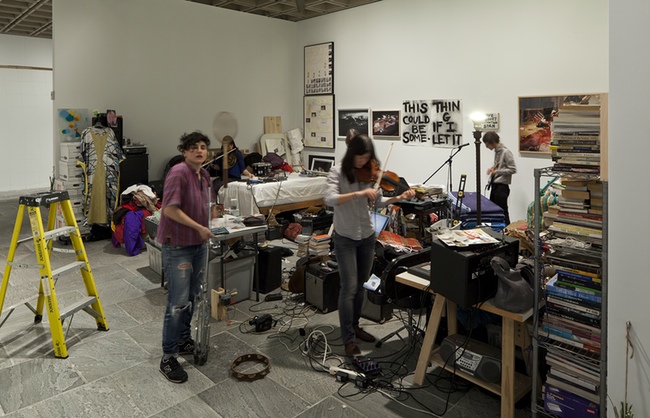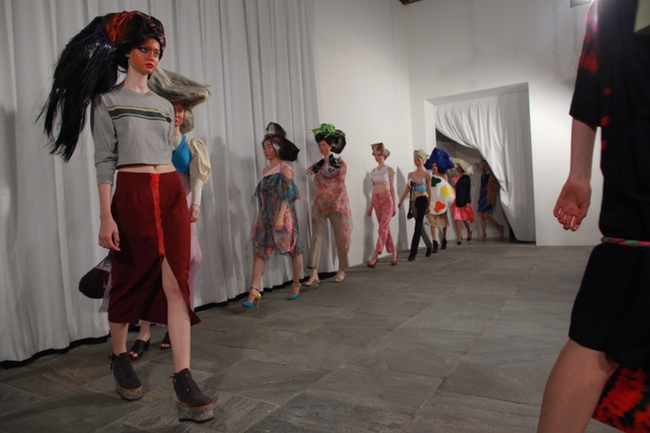
Installation view, Whitney Biennial (2012)
Looking back at the time in which I was beginning to study art, one could describe the motivations I shared with my peers as generally aspirational and humanitarian. We felt different. We wanted to change the world. We thought of the institution of art as a discipline in which alternative personalities flourish, critical thinking is lauded, and that creativity (in all of its various forms) is esteemed far more than financial privilege. Having participated in the art industry for a number of years, these ideas now seem not only naïve, but provide a blueprint for precisely how the art world does not operate; our collective wills becoming inured to the faux-radical, contradictory reality that the institution of art exists in today.
On the occasion of the 2012 Whitney Biennial, Andrea Fraser writes of the crisis of the art institution, “The glaring, persistent, and seemingly ever-growing disjunction between those legitimizing discourses [of art]—above all in their critical and political claims—and the social conditions of art generally…has appeared to me as profoundly and painfully contradictory, even as fraudulent.” Her essay for the Biennial catalogue “There’s no place like home,” painstakingly delineates what she perceives to be the impossibility of participating in the institution of art in good conscience due to its compliant enrichment from the increasing financial inequality of the last decade. Acknowledging the fact that this inequity is precisely what art purports to act against, Fraser considers possible methods through which this quandary may be alleviated. She posits, almost fatalistically, that “Certainly it is less painful to resolve these conflicts symbolically, in artistic, intellectual, and even political gestures and position-takings, than to resolve them materially—to the marginal extent that it is within our power to do so in our own lives—with choices that would entail sacrifices and renunciations. Even these sacrifices may be preferable, for some, to the pain of wanting what we also hate, and hating what we also are and also love...” Heady prose for a biennial catalogue.

Dawn Kasper

K8 Hardy, May 20th, 2012 at 2012 Whitney Biennial
Taking Fraser’s essay as preamble, 2012 Whitney Biennial co-curators Jay Sanders and Elizabeth Sussman have approached the nearly insurmountable task of surveying the art of the last two years by symbolic rather than material means. While Fraser’s essay wills itself to question the increasing intermingling of the 1% within the institution of art, and the resultant ethical quandary artistic practice currently finds itself in, the visual component of the 2012 Whitney Biennial installed in the Breuer building does little to directly comment on our current economic precariousness or the Occupy Movement. Instead, within the Biennial itself we see implicit critique in the form of a litany of objects. As leitmotifs we see a return to craft, the privileging of the visual over the logocentric, a concerted concentration on queer art, a rejection of sophistry in approaching disciplines peripheral to object-based fine art, historical excavations of “lost” artists, and the blurring of the roles of the artist with the curator and even collector. Sculpture, performance, dance, film, video, installation, and painting all make appearances here, and sensational “size queens,” as Jerry Saltz has put it, are thankfully absent.
At first glance, the 2012 Biennial seems precisely the sort an ex-dealer would curate, privileging works that are imbued with obvious signifiers of value and that are, well, easy to collect: we see the craft-heavy, hand-strewn, colorful and intimately scaled. Most of the modest 51-person biennial is installed as airy “micro-exhibitions,” providing little formal interplay between installations spare Lutz Bacher’s existential “Selections from the Celestial Handbook,” framed pages ripped from what appears to be a monochromatic astrological guidebook, interspersed through the Whitney’s entire five floors. Individual offerings seem to come from a neo-Modernist viewpoint, highlighting the artist’s subjectivity, which often seems located on the fringes of society. In turn, for an exhibition that is charged with task of culling everything au courant, the Biennial seems resolutely old—we see no slick post-post-Minimalism, no text-laden PoMo. On closer investigation, the Biennial unfolds as a profound reaction against the proliferation of what the curators term “art school art,” or the work of hyper-educated artists rooted in pedantry as much as artistic production. Though it seems strange, if easy, to return back to a Modernist modus operandi, the Biennial seems critical by negation, rather than decisive by augury.

Werner Herzog, Hearsay of the Soul (2012)
Sanders and Sussman’s most distinctive maneuver is their inclusion of several artists who chose to mount exhibitions of other artists’ work, often in an effort to correct what is perceived by the biennialist as a historical wrong. The most obvious and talked about is Robert Gober’s curatorial installation of Forrest Bess’s abstract paintings, alongside photographs of the artist’s self-inflicted surgeries to transform himself into a pseudo-hermaphrodite. Bess frequently sent these photos to his dealer, Abstract Expressionist patroness Betty Parsons, to be mounted in proximity to his paintings, from which she always shied away. Having mounted a brilliant retrospective of the work of saturnine American painter Charles Burchfield at the Whitney in 2009, Gober has effectively cast his involvement in these projects as not simply a curator or an artist, but as something in between, demanding at once the insight of an artist, as well as the collaborative spirit and commitment to research endemic to a curator. Gober has paved the road legitimizing such a practice for other artists, such as Nick Mauss, who, along with his own work, installed etchings and drawings from the museum’s collection that are all variably queer in nature—ranging from the well-known Warhol and Ellsworth Kelly to the lesser-known May Wilson and Eyre de Lanux—as his contribution to the biennial. And curiously, lastly, when the documentary guru Werner Herzog was asked to participate in the biennial, he sought to abandon his usual filmmaking efforts and install the paintings of the generally forgotten seventeenth-century Dutch artist Hercules Segers (c. 1590–1638), a contemporary of Rembrandt who Herzog sees as the originator of Modernism. Titled “Hearsay of the Soul” Herzog’s biennial contribution consists of a five-channel projection of digital documentation of Segers’ paintings, which are set to an epic violin score composed and played by Dutch musician Ernst Reijseger.
Similarly unique in approach is the Biennial’s film program, curated by Light Industry co-directors Ed Halter and Thomas Beard, who organized a mini-cinema for films to be viewed in their entirety, rather than chanced upon mid-film as an installation setting would facilitate. Says Beard, “The way that film and video tends to be exhibited within contemporary art contexts reflects a shift in the way we've come to relate to information after the advent of the internet. There's this suggestion that a mere awareness of something is tantamount to knowing it in a meaningful way. Wandering through a series of video loops, what we're often left with, unfortunately, is the museum as link dump.” Speaking of his decision to install the film program to be viewed in a theater setting, each film running from start to finish, rather than in a loop, Beard posits that it’s the very function of the 2012 biennial to circumvent the superficiality with which the contemporary art world often approaches not only film, performance, dance, music, and theater, but also object-based artwork itself.

Moyra Davey, Darling, 2011. Chromogenic print
Although the Biennial was generously inclusive in its range of practices such as dance and film, it only treads lightly in the realm of new media, unlike past biennials such as that of 2000. Rather, the curators include an array of arguably nostalgic, analog technology-based works, namely in the form of slide projections or celluloid film. Luther Price’s late-90’s works take found 16mm film depicting documentaries, as well as medical and family footage. The found film is then re-edited and used as a material base in itself, for scraping, burying, staining, etc. More redundant and pretentious is Lucy Raven’s “RPx, 2012 (in progress),” a slide collection of calibration charts and test patterns that supposedly act as a “formalist genre,” but really just look like wallpaper-level, colorful geometric abstract painting one would find in a hipster Lower East Side gallery. While Raven’s project illustrates two principles—that the calibration slide is a unique object solely existing to “make you see better,” and that the era wherein human beings worked in tandem with a technological apparatus to enhance its performance has largely now passed—the artist does little to reflect upon the significance of these phenomena on a human level. When taking into consideration contributions such as Fraser’s that cut to the heart of what it means to be an artist—as well as a human—in our economic and political climate, works as indulgent as throwing together a bunch of pretty old slides read as fluffy in comparison.

Nick Mauss, Material Studies, (2008-11) (detail).
Circulating around the Biennial, I attempted to come up with a profile of precisely what breed of art Sanders and Sussman react against. In a breakthrough moment in John Kelsey’s catalogue essay “High Lines (for Sick Bees),” he writes of an hollowed-out “emo style” propagated by young contemporary artists that may dictate the art of tomorrow. He writes, “…in regards to the function of blogs like Contemporary Art Daily[,] MFA grads are making cozy, nice, unassuming, slightly frazzled, handcrafted works that are designed to speed like bullets (but without hitting anything). Artworks are improvised in relation to all the information that flies through them. Like dream catchers.” We all know this kind of work: it’s hypersalable, slick, obviously learned, probably shown in the Lower East Side. It works just as well in a gallery as it could a showroom, and only lightly ironically. It’s created to communicate how intelligent it is, and to be sold. It’s nauseatingly shallow. It may be sold at auction in five years at 500% profit, or the artist may disappear entirely.
There’s something about this model—which works for writers and curators as it does artists on all levels—that’s universally familiar as it is upsetting: those who have learned to play the game and strategize are generally rewarded by exhibition opportunities, commissions, gallery dinners, those impossible-to-find entry level jobs, et cetera. Yet this modus operandi that celebrates strategy, money, power, and class, and disavows egalitarianism seems existentially at odds with what we’re all here for: to look, and examine closely, to generate ideas that examine why life is worth living, and to attempt to understand with more gravity what it means to be a human being on this planet. And while I’m treading in the dangerously reductive territory of setting up a binary relationship between the “good” subject and the “evil” other, there’s something fitting about such an idea in the harrying political climate laid before us. To return to Sanders and Sussman, there’s a wholeness that the biennial propagates, one that returns fine art to its primary impetus. It’s refreshingly internal, sincerely rejecting the idea that art is simply a luxury industry servicing a sea of unchecked egos. Yet, rather than looking toward past, arguably outdated modes of artmaking, what are we to do with the work of the present? It’s empty upon creation, and as Kelsey so aptly puts it, so light that it zips through hands and time “without hitting anything.” How do we fill an artwork? To Fraser, the answer would lie in honest, engaged discourse, and to Sanders and Sussman, time, compassion and dedication—all worthy options on our path to 2014.

